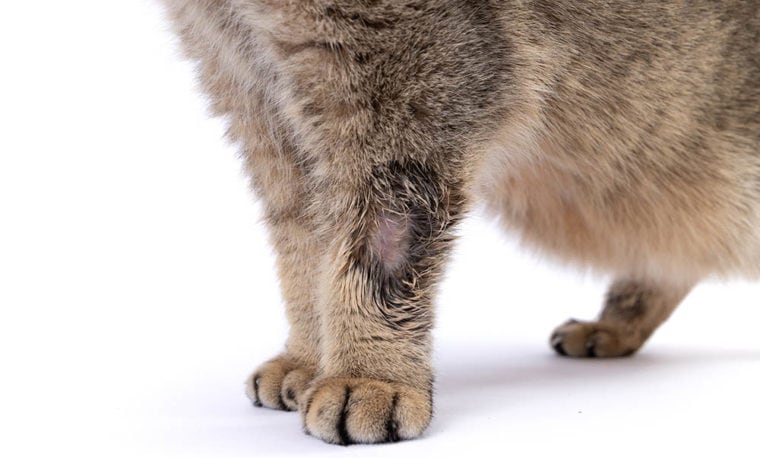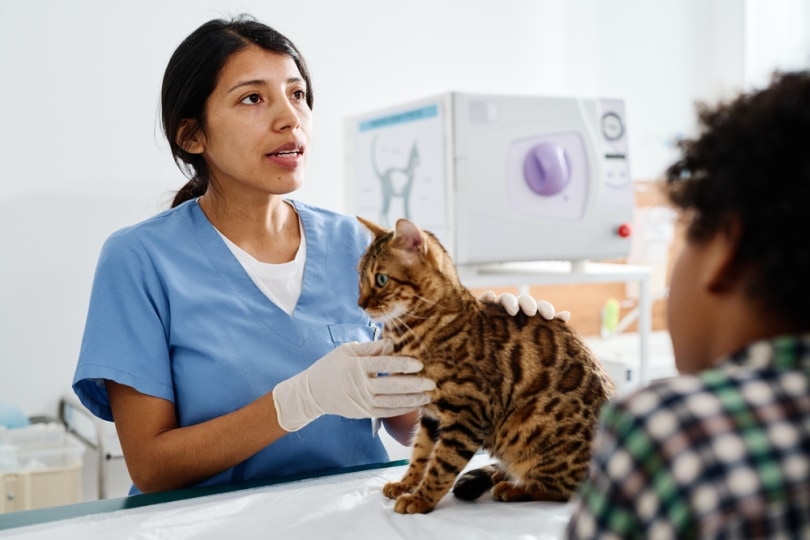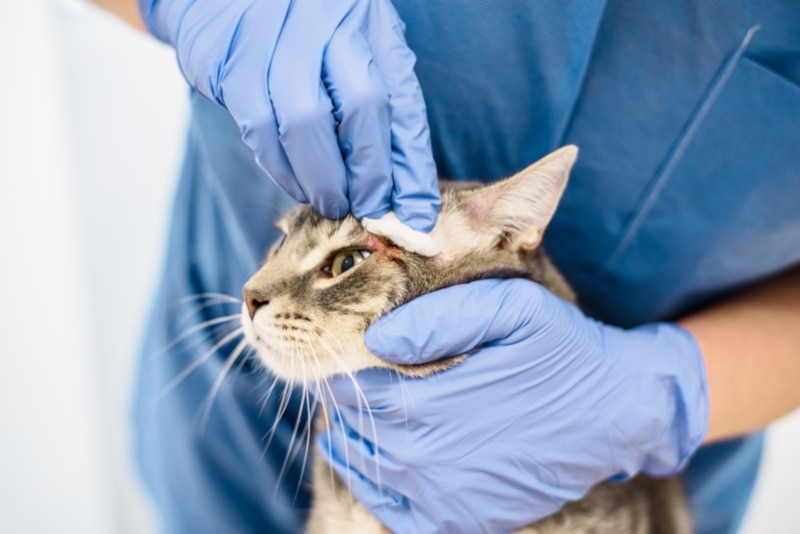
Click Below to Skip Ahead
A mycosis is when a fungal infection causes disease in an animal. And the truth is, there is a big wide world out there of potential fungal infections that could affect your cat! While there are numerous types of fungi such as molds and yeasts, there are also many individualized species of these types that can pose a health threat to your cat.
While mycosis can be an overwhelmingly complex topic, in this article we’ll keep things simple by focusing on more general causes, signs, and treatments for commonly seen fungal infections in our feline friends.
What Is a Fungal Infection?
Fungi are in a diverse kingdom of related species that include molds and yeasts, among other types. They produce spores (a single cell that can reproduce) and can be parasitic in that they are sometimes a health detriment to their host. If a cat does get infected, the fungus will set up shop in an area (or spread to multiple areas) and cause signs of an infection. This can be systemic (affecting more of the whole being, rather than a single part) or located in one specific area (such as the skin for example).
Pathogenic fungal infections are fungi species that can cause an infection even in a healthy cat. Conversely, an opportunistic fungal infection occurs when the cat is otherwise ill, weak, or immunosuppressed, which then leads to the body being more susceptible than normal to a fungus to which it is exposed.
While the concept of fungal infections is very broad, each fungi species will have its own characteristics including where it’s most commonly located, the signs it can cause, what locations in the body are typically affected, how it might be best diagnosed, and the most effective form of treatment. Some kinds of fungal infections that can occur in cats include:
What Are the Signs of a Fungal Infection?

Signs of a fungal infection in cats will depend on several factors such as the location and severity of infection as well as the fungal species present. For example, a common ringworm fungal infection of the skin will vary in signs compared to a fungal lung infection or a fungal bladder infection, etc.
Some signs of a fungal infection of the skin could include hair loss, itchiness, ulceration, and scaly or red skin. Fungal infections that are on or in the bone may result in limping. If the nasal cavity is affected, sneezing, long-term nasal discharge, and swelling in the area can occur while a fungal infection further along in the respiratory tract may cause additional upper respiratory signs like coughing or difficulty breathing.
If the fungal infection is associated with the eye, there may be eye swelling and inflammation, dilated pupils, or even blindness. Neurological problems that could occur from a fungal infection affecting the nervous system might include seizures, circling movements, or changes in temperament. Systemic signs that affect the entire body include fever, enlarged lymph nodes, decreased appetite, lethargy, and weight loss over time.
What Are the Causes of a Fungal Infection?
The causes of a fungal infection can be multifaceted. Some types of fungi are located almost everywhere in the environment while others are found only in specific geographic locations. In general, fungal spores are found in the environment, most commonly in the soil, as a reservoir. They spread by producing small spores that can remain there or travel. They could move into a new area of the environment via an infected host animal, or via a fomite (a contaminated object that contains the fungi/spores such as furniture, bedding, brushes, etc.) It has also been found that longer-term use of antibiotics or immunosuppressive drugs can make a fungal infection more likely.
The spores of fungi can be inhaled, ingested, or come into direct contact with the bloodstream via a wound. Next, they set up shop where they may become a parasitic organism and may even spread to other areas of the body.
How Do I Care for a Cat with a Fungal Infection?

If your cat has a fungal infection, veterinary care will likely need to be implemented to help your pet resolve their infection.
Fungal Toxicosis in Cats
A fungal toxicosis is more commonly referred to as mycotoxicosis and this concept is different from a mycosis. As discussed earlier, a mycosis occurs when a fungal agent infects the body and causes negative signs in the host. In contrast, mycotoxicosis occurs when a fungus produces a toxic chemical called a mycotoxin, which then causes negative signs in organisms. In short, in this case, instead of the fungus itself causing the infection, it’s the byproduct made by the fungus that then causes the problem.
This disease process is not contagious and most commonly affects animals, including cats, by being in contaminated food that then gets eaten. There are over 250 mycotoxins that have been discovered and numerous different types of mycotoxicosis can then result in disease for animals. It is more common to see large animals infected, but it can, and has occurred in cats. An example of a fungal species that produce mycotoxins is Fusarium which most commonly affects corn and/or wheat. This fungal species specifically produces the different mycotoxins fumonisins, trichothecenes, and zearalenone. These mycotoxins have been identified and detected in measurable amounts in cat food before though much more research is needed to determine the significance or amounts which may be of a large health concern.
Animals affected by mycotoxicosis may have vomiting or diarrhea, may not want to eat, or may lose weight. Mycotoxins are difficult to diagnose and often require various forms and phases of testing for veterinarians to determine they are present. Removing the affected food or source removes any further exposure or contamination. If there are any secondary signs from the mycotoxicosis such as dehydration or weight loss, these will need to be treated by your cat’s veterinarian as well.
Frequently Asked Questions (FAQ)

How is a fungal infection diagnosed?
A veterinarian will use a complete history and physical exam to begin. These things combined will help them pinpoint the next steps and identify which specific tests may be warranted. Tests that provide a sample of the affected area to be observed under the microscope or a fungal culture can be helpful. A biopsy or a larger sample of the area collected and sent to a specialist to examine may also be needed. Specific labwork that can check for a fungal organism in the blood, urine, or for antibodies may help identify fungal infections.
An FIV and FeLV test may help a veterinarian recognize if there is a separate ongoing infection that may allow for opportunistic parasites such as fungi to be more likely. In respiratory cases, X-rays to examine the lungs may be recommended. At times, even further specialized care or tests such as a CT or MRI may need to be explored.
How is a fungal infection treated?
The specific type of fungal infection as well as the infection’s location within the cat’s body will determine which course of treatment to pursue. It is important to note that fungal infection can take long periods of time to treat, often many weeks to months. Furthermore, these infections, even if treated, may reoccur as reinfection can be common. This could potentially be due to ongoing environmental contamination, being around other animals that are affected, etc. Some common forms of antifungal treatment include medicated wipes, ointments, or shampoos as well as oral medications.

Can my cat’s fungal infection spread to others?
Yes, although it depends on the type of fungus as some are contagious while some others are not. Other factors, such as whether the fungi are pathogenic or opportunistic will come into play. Overall, some types of fungi can be zoonotic. This means that the organism that can cause the infection, in this specific case a fungus, can spread from animals to humans and vice versa.
Conclusion
The world of fungi is a dizzyingly large and complex one. Here, we have reviewed a few basic principles of how fungi may negatively affect cats, including causes, signs, and treatment, as well as the differences between mycosis and mycotoxicosis. Because knowledge is power, learning about how and why fungi can pose a health risk to your feline friend will help you to be your cat’s best advocate and suspect when to seek professional medical care!
Featured Image Credit: Nadya Bessonov, Shutterstock








